Understanding Pug Diarrhea and Vomiting: Causes and Solutions


Intro
Diarrhea and vomiting in pugs are distressing symptoms that can signify underlying health issues. Pugs, known for their charming personalities and unique physical traits, are not immune to gastrointestinal problems. Understanding the reasons behind these symptoms is crucial for every pug owner. This guide explores causes, symptoms, prevention, and treatment options, aiming to enhance the health and well-being of your beloved pug.
Understanding Your Pet
Breed Traits
Pugs are brachycephalic dogs, characterized by their short snouts. This breed trait can sometimes lead to unique health challenges. Their structure makes them prone to specific gastrointestinal issues that may contribute to diarrhea and vomiting. Moreover, pugs often have sensitive stomachs, requiring careful attention to their diet.
Common Temperaments
Pugs are often described as sociable and playful. They thrive in family settings and are known for their affectionate nature. However, stress and anxiety can also affect their eating habits and digestive health. A stable environment is beneficial for maintaining their overall well-being.
Special Needs
Special care is essential for pugs due to their unique physiology. Owners should be vigilant regarding their pug’s weight as obesity can exacerbate health problems, including gastrointestinal distress. Regular vet check-ups and a balanced diet tailored for pugs are critical in addressing these special needs.
Pet Care Essentials
Nutrition and Feeding Guidelines
Proper nutrition is foundational for pug health. Feed them high-quality dog food formulated specifically for their breed. Look for products that offer a balance of protein, carbohydrates, and fat. Avoid sudden changes in diet, which can lead to digestive upset. Furthermore, consider feeding smaller meals throughout the day to lessen the chance of stomach irritation.
Grooming Tips and Techniques
Maintaining a pug’s hygiene is vital. Regular grooming helps prevent skin infections, which can also lead to a lack of appetite. Brush their coat frequently, paying attention to the facial folds where moisture can accumulate. Cleaning their ears and trimming their nails are also necessary steps in proper grooming practices.
Health and Wellness
Keeping an eye on your pug's health goes beyond just observing their physical condition. Routine veterinary check-ups are essential for monitoring their overall well-being. Vaccinations should be kept up to date, and owners must watch for signs of illness, including any changes in appetite or behavior.
Training and Behavior
Basic Training Techniques
Training a pug requires patience and consistency. Positive reinforcement works very well with this breed. Use treats or praise to encourage good behavior. Basic commands should be taught early to establish a strong communication link between you and your pug.
Behavioral Problems and Solutions
Pugs can develop behavioral problems that affect their health. Excessive barking, chewing, or anxiety may indicate underlying issues. Engaging them in regular play and mental stimulation activities can help mitigate these problems. If issues persist, consulting a professional trainer may be necessary.
Mental Stimulation Activities
To keep their minds active, provide various toys and activities. Puzzle toys and interactive games can help prevent boredom and promote healthy mental stimulation. Scheduled playtime helps forge a stronger bond and keeps your pug engaged throughout the day.
Engaging with Your Pet
Interactive Games and Toys
Innovative toys are an excellent way to engage with your pug. Look for activities that also promote physical health, like fetching or tug-of-war games. These activities not only provide exercise but also enrich their daily life.
Safe Outdoor Activities
Exercise is crucial for pugs, but it must be done carefully. Pugs can overheat easily due to their anatomical traits, making shorter walks or play sessions in cooler weather preferable. Always monitor them for signs of exhaustion.
Family-Friendly Pet Interactions
Pugs are naturally social animals. Encourage family members to participate in activities with them. This helps create a nurturing environment and builds strong connections among family and pet, which is beneficial for the pug’s emotional health.
Pet Adoption and Integration
Choosing the Right Pet for Your Lifestyle
Adopting a pug requires consideration of your lifestyle. Their needs are unique, and potential owners should assess their capacity to accommodate these traits. Assess your time, living situation, and ability to commit to health care.
Preparing Your Home for a New Pet
Before bringing a pug home, ensure the environment is safe. Secure loose items and toxic plants. Designate a comfortable sleeping area and establish a feeding routine for consistency.
Tips for Smooth Foreword


When integrating a new pug into your home, patience is essential. Allow the pug to explore gradually, and establish a gentle routine. Encourage gradual introductions to family members and other pets to foster a harmonious living environment.
In summary, understanding your pug's needs and behavior is fundamental in preventing and addressing diarrhea and vomiting. Comprehensive care and vigilance can significantly enhance your pug's quality of life.
Foreword to Pug Health Issues
Pugs are beloved companions known for their distinctive appearance and endearing personality. However, these dogs are prone to a range of health issues that can significantly impact their quality of life. After all, understanding the potential health concerns is crucial for any pug owner. This article focuses on an important aspect of pug health, specifically gastrointestinal problems, which include diarrhea and vomiting.
Importance of Monitoring Gastrointestinal Health
Gastrointestinal health plays a vital role in the overall well-being of pugs. Their sensitive digestive systems can react poorly to a variety of factors. Therefore, monitoring their gastrointestinal health is essential. Regularly observing their eating habits, bowel movements, and any signs of discomfort can help identify issues early on.
When problems in the digestive tract arise, they can lead not only to discomfort but also to serious health complications. Early recognition of symptoms such as diarrhea or vomiting allows for timely intervention, which can be lifesaving in certain situations. By being vigilant, pug owners can ensure their pets stay healthy and happy.
Overview of Common Health Problems in Pugs
Pugs, like all dog breeds, face a range of health concerns. While some issues are inherent to their unique anatomy, others can arise from environmental factors or owner attentiveness. Common health problems in pugs include:
- Respiratory Issues: Pugs are brachycephalic, which means they have short snouts. This structure can lead to breathing difficulties.
- Skin Conditions: Allergies and infections can affect a pug's skin, leading to discomfort and itching.
- Obesity: Pugs love food, and their small frames make them susceptible to weight gain, which can lead to further health complications.
- Gastrointestinal Problems: As discussed, gastrointestinal issues such as diarrhea and vomiting are frequent concerns for pug owners.
Being aware of these health problems can aid pug owners in preventative care. Regular check-ups with a veterinarian can help manage and even prevent many of these conditions, ensuring a longer, healthier life for these amazing pets.
Understanding Diarrhea in Pugs
Understanding diarrhea in pugs is essential for any responsible owner. Diarrhea can indicate a range of health concerns, from simple dietary indiscretion to serious infections. Pugs have unique health issues due to their distinct physiology. Therefore, recognizing the signs and symptoms can significantly impact their well-being and recovery.
Definition and Types of Diarrhea
Diarrhea refers to the condition where a dog has watery or loose stools. It is classified into several types: acute, chronic, and persistent. Acute diarrhea often occurs suddenly and lasts for a short time. Chronic diarrhea lasts for weeks, often indicating an underlying condition. Persistent diarrhea does not resolve despite treatment and requires further investigation.
Possible Causes of Diarrhea in Pugs
Dietary indiscretion
Dietary indiscretion is a common cause of diarrhea in pugs. This typically occurs when a pug consumes inappropriate food, which may include human food or spoiled items. Pugs are known for their curious nature, leading them to eat what they shouldn't. This aspect is crucial because such behavior is widespread among dogs. The unique feature of dietary indiscretion is its immediate impact; diarrhea often begins within hours after ingestion. The advantage of understanding this cause is that it can often be resolved quickly by adjusting the diet.
Food allergies
Food allergies may also cause diarrhea. In pugs, common allergens include proteins like beef, chicken, or grain sources. Identifying this allergy can be complex since symptoms often overlap with other health issues. The critical characteristic of food allergies is their delayed reaction; symptoms may appear days after consuming the allergen. Understanding food allergies can help pug owners eliminate problematic ingredients, benefiting the dog's overall health.
Parasites
Parasites such as Giardia and roundworms are another significant concern. They invade a pug's intestines, causing diarrhea and other gastrointestinal issues. The key characteristic of parasitic infections is their contagious nature, posing a risk to other pets. Recognizing the possibility of parasites early can lead to timely treatment and prevent further health complications.
Illness or infection
Illness or infection can result in diarrhea as well. Conditions such as parvovirus or bacterial infections lead to severe gastrointestinal distress. The notable factor here is the severity of the illness, which can quickly escalate if left untreated. Understanding this cause emphasizes the need for prompt veterinary care in cases of persistent diarrhea.
Medications
Certain medications, especially antibiotics, can disrupt a pug's gut flora and result in diarrhea. The effect of medications on the digestive system highlights the importance of managing dosage and purpose. Discussing any side effects with a veterinarian is essential prior to introduction.
Recognizing Symptoms of Diarrhea
Recognizing the symptoms of diarrhea is critical for pug owners. Key indicators include the consistency of stool, frequency of bowel movements, and the presence of blood or mucus.
Consistency of stool
Assessing the consistency of stool provides significant insights into a pug's digestive health. Watery or liquid stool indicates a more severe issue, while semi-formed stool may suggest a mild problem. Noticing changes in stool consistency should prompt monitoring or veterinary consultation, as this can indicate a change in health status.
Frequency of bowel movements
Frequency is another key aspect. An increase in the number of bowel movements can indicate abnormal digestive function. Normal frequency varies per dog, but more than three to four times a day can signal a problem. This detail can guide pug owners on when to seek veterinary advice based on their pet's regular patterns.
Presence of blood or mucus
The presence of blood or mucus in the stool serves as a warning sign that shouldn't be ignored. Blood often indicates a severe infection or gastrointestinal damage, while mucus may signal inflammation. Understanding these symptoms is vital for early detection, allowing for timely interventions.
Exploring Vomiting in Pugs
Understanding vomiting in pugs is crucial for pet owners. It provides key insights into pug health and helps identify potential issues before they escalate. Recognizing the signs of vomiting can lead to timely diagnosis and treatment, protecting your pet's well-being.


What Constitutes Vomiting
Vomiting is the act of expelling the contents of a dog’s stomach through the mouth. Unlike regurgitation, which is a passive process, vomiting typically involves abdominal contractions and can be accompanied by other symptoms. Understanding this difference is important as it affects how one approaches treatment and care decisions.
Underlying Causes of Vomiting in Pugs
Overeating
Overeating is a common problem in pugs. This issue arises when a pug consumes more food than their stomach can comfortably hold. A key characteristic of overeating is the expulsion of undigested food, often shortly after eating. This can create discomfort for the dog and lead to further health issues. Addressing overeating requires attention to portion sizes.
Change in diet
A sudden change in diet can provoke vomiting in pugs. This might occur if the dog transitions to a new food brand too quickly or if new treats are introduced. The key characteristic here is the pug's gastrointestinal sensitivity. Pugs often do better when dietary changes are made gradually. Understanding this aspect helps owners manage dietary transitions effectively.
Intestinal obstruction
Intestinal obstruction occurs when an object blocks the intestines. This is a serious condition that can lead to severe health risks. A key characteristic is the sudden onset of vomiting, often accompanied by lack of appetite and lethargy. Recognizing this sign can be lifesaving; urgent veterinary attention is necessary for treatment. Identifying potential hazards in the pug's environment can mitigate this risk.
Toxins
Exposure to toxins can lead to vomiting in pugs. Common toxins include certain plants, foods like chocolate, or human medications. The key characteristic of toxin ingestion is often rapid, intense vomiting. Recognizing the signs can help owners seek immediate help. Understanding what is toxic is essential for prevention. These knowledge makes pugs safer and healthier pets.
Symptoms Accompanying Vomiting
Frequency of vomiting episodes
The frequency of vomiting episodes is an important indicator of overall health. Occasional vomiting may not be serious, but multiple episodes within a short time frame can indicate underlying problems. This symptom warrants closer monitoring. Identifying patterns helps in determining when to seek veterinary advice.
Presence of bile
Bile in vomit gives specific information about a pug's condition. Vomit that contains bile often indicates that the stomach is empty, which can signal underlying conditions like pancreatitis. Monitoring this symptom is beneficial because it can provide early clues for potential health issues. Early detection can facilitate more effective treatment.
Behavior changes
Behavior changes often accompany vomiting. A pug showing signs of distress, increased lethargy, or changes in appetite after vomiting may need immediate attention. This symptom is notable because it reflects the overall well-being of the pet. Changes in behavior can be subtle but significant in guiding owners on the appropriate steps to take for their pet's health.
Understanding these causes and symptoms can empower pug owners to act quickly and appropriately in the face of health issues.
When To Seek Veterinary Help
Understanding when to seek veterinary assistance is crucial for pug owners. Pugs, like other breeds, can experience serious health issues due to diarrhea and vomiting. Recognizing signs that warrant immediate attention can make a significant difference in outcomes. Timely medical intervention helps ensure prompt diagnosis and appropriate treatment.
Signs Indicating Urgent Care
Persistent vomiting or diarrhea
Persistent vomiting or diarrhea can indicate serious underlying conditions. The continuous loss of fluids and nutrients may lead to dehydration. This is a critical aspect since it can escalate quickly into more severe health problems. Owners should monitor their pug's behavior if these symptoms persist beyond 24 hours. The urgency of this condition cannot be overstated; it requires swift veterinary intervention to prevent further complications. The unique feature of persistent vomiting or diarrhea is its potential to manifest other underlying issues such as infections or gastrointestinal disorders.
Signs of dehydration
Dehydration is a direct result of vomiting or diarrhea, and recognizing its signs is essential. Key indicators include dry gums, sunken eyes, and lethargy. Dehydration can severely complicate a pug's health, making it essential for owners to act quickly. The distinctive characteristic of signs of dehydration is that they become pronounced after fluid loss exceeds a certain threshold. Delaying treatment might lead to hospitalization, which is not ideal for small breeds like pugs. Immediate veterinary care can often mitigate further health decline.
Severe lethargy
Severe lethargy is another sign that may indicate serious health problems. A pug that is unusually tired or unresponsive warrants immediate veterinary attention. This sign suggests that the pug may be experiencing significant distress or illness. The unique aspect of severe lethargy is that it often accompanies other worrying signs like persistent vomiting or diarrhea. Understanding the relationship between these symptoms can help owners make informed decisions about seeking veterinary help before conditions worsen.
Diagnostic Tests for Pug Health Issues
To properly assess a pug's health issues, various diagnostic tests can be employed. These tests help veterinarians identify the underlying causes of symptoms such as vomiting and diarrhea.
Fecal examination
A fecal examination is a fundamental diagnostic tool. It allows vets to identify parasites, infections, or other abnormalities. The simple collection of a stool sample can provide significant insights into a pug's gastrointestinal health. This test is beneficial and commonly recommended when gastrointestinal symptoms arise, offering quick results that can aid in devising a treatment plan. The unique advantage of fecal examinations is their non-invasive nature and ability to quickly detect serious issues that could worsen if left untreated.
Blood tests
Blood tests are another essential component in diagnosing health issues. They assess organ function and detect infections or imbalances in bodily systems. This can be particularly advantageous in understanding the overall health status of a pug. Blood tests can reveal underlying issues that may not be immediately obvious, providing a holistic view of the pug's health. The distinct feature of blood tests is their diagnostic breadth, which can uncover multiple problems that might present with similar symptoms.
Imaging studies
Imaging studies, such as X-rays or ultrasounds, provide a visual assessment of a pug's internal condition. These tests help clarify problems not detectable through blood tests or fecal examinations. The unique characteristic of imaging studies is their ability to visualize structural problems, such as blockages or tumors. This aids in creating an effective treatment plan. However, such procedures are more invasive and often require sedation, which must be weighed against their diagnostic benefits.


Treatment Options for Diarrhea and Vomiting
Treatment for diarrhea and vomiting in pugs is vital. These issues can lead to dehydration and other health concerns if not addressed promptly. Understanding the options available empowers pug owners to take appropriate action. It also minimizes discomfort for the pet and ensures a quicker recovery.
Dietary Management
Temporary withholding of food
Temporary withholding of food can be an effective first step. It allows the gastrointestinal tract to rest and recover. This practice is beneficial for reducing the frequency and severity of diarrhea and vomiting. Many owners find this method helpful because it does not involve medications, which can have side effects.
However, it must be done cautiously. Dogs should only be without food for a short period, generally 12 to 24 hours. Young puppies or ill pets might require immediate food intake even if they are vomiting. The key is to monitor their condition closely during this time.
Prolusion of bland diets
After a short period of withholding food, many veterinarians recommend introducing a bland diet. This diet typically consists of plain boiled chicken and rice or a special veterinary diet formulated for gastrointestinal issues. Several advantages accompany this approach; the blandness minimizes irritation to the stomach.
Such diets are often considered favorable as they are easy to digest. Pug owners appreciate this method because it helps stabilize the gut while still providing nourishment. However, transitioning too quickly back to regular food can lead to setbacks.
Reintroduction of regular diet
Reintroducing a regular diet is the final step needed once the pug shows signs of recovery. Slowly incorporating their usual food is critical. It helps dogs transition back without burdening their digestive system. Pug owners benefit by ensuring their pets do not experience distress during refeeding.
This step is characterized by gradual increases in normal diet portions. It’s important to watch for any returning signs of diarrhea or vomiting during this process. If symptoms reappear, recurrent vet check-ups may be necessary to address underlying issues.
Medications for Symptom Relief
Anti-nausea medications
Anti-nausea medications can play an essential role in treating pugs. These medications help to alleviate symptoms of vomiting, making pets more comfortable. Many drugs are available, and veterinarians often select the one that best fits the individual dog's needs, considering any underlying issues.
The primary feature of these medications is their effectiveness in reducing vomiting episodes. Pet owners often favor them because they can lead to improved quality of life during recovery. Nonetheless, utilizing these without veterinary guidance is not wise, as they vary by situation.
Probiotics
Probiotics can significantly impact gut health and recovery. They consist of beneficial bacteria that help restore the natural balance of flora in the intestinal tract. Many pug owners are inclined toward probiotics as a preventive measure and for symptom relief. They can be a natural solution that promotes overall health. However, the benefits depend on the specific formulation used. Therefore, choosing high-quality products is essential.
Antibiotics
In some cases, antibiotics may be necessary to combat infections. These medications help eliminate harmful bacteria that might cause gastrointestinal distress. Antibiotics can be an effective option for pugs experiencing severe symptoms due to bacterial infections.
While beneficial, caution is needed. The misuse of antibiotics can lead to resistance and other health issues. Pet owners should always consult with a veterinarian to determine the appropriateness of this treatment option for their pug’s condition.
Treating diarrhea and vomiting without proper guidance can lead to worsening conditions. Always consult a veterinarian before starting any treatment protocol.
Preventive Measures for Pug Owners
Preventive measures play a crucial role in maintaining the health of pugs, particularly in relation to gastrointestinal issues such as diarrhea and vomiting. For pug owners, understanding and implementing these measures can greatly reduce the likelihood of such problems arising. Proactive care strengthens the immune system and minimizes stress, enhancing the overall quality of life for pugs.
Importance of a Consistent Diet
One of the key aspects of preventive measures is ensuring a consistent diet. Pugs are known to have sensitive digestive systems. Sudden changes in diet can disturb their gastrointestinal tract, leading to diarrhea and vomiting. A consistent diet helps maintain digestive balance and can prevent these ailments. Additionally, selecting high-quality dog food specifically formulated for pugs or small breeds is essential. These diets typically contain nutrients adapted to their metabolic needs, thus promoting overall health.
Maintaining Hygiene and Cleanliness
Regular cleaning of feeding areas
The cleanliness of feeding areas cannot be overstated. Regular cleaning prevents the accumulation of bacteria, parasites, and other pathogens that could affect a pug's digestive health. Keeping feeding bowls clean minimizes the risk of food contamination, which is a significant contributor to gastrointestinal issues. Moreover, ensuring that the feeding area remains tidy promotes a good eating habit and can be beneficial to the pug's mental well-being. Providing a fresh and visually appealing space for meals is a simple yet effective preventive measure.
Proper disposal of waste
Proper disposal of waste is equally crucial in preventing gastrointestinal issues in pugs. Leaving waste unattended can attract unwanted attention from pests, which may carry diseases that affect dogs. It is vital to dispose of waste swiftly and responsibly to maintain a healthy environment for your pet. Additionally, ensuring that waste is removed minimizes odor and contributes to a cleaner living space. This practice is not only beneficial for pugs but also for the overall hygiene of the home.
Keeping both feeding areas and waste disposal areas clean can significantly reduce the chances of your pug experiencing gastrointestinal problems. Consistent hygiene practices are essential for health and well-being.
End
Understanding the issues related to diarrhea and vomiting in pugs is essential for responsible pet ownership. These gastrointestinal problems are not only uncomfortable for the pet but can also indicate serious underlying health issues. Timely recognition of symptoms can significantly improve the outcomes for affected pugs, leading to better health management.
Final Thoughts on Pug Health Management
Taking care of a pug's health involves more than just feeding and exercise. Owners must be vigilant about monitoring their pets for any signs of discomfort. Routine veterinary check-ups, a balanced diet, and good hygiene practices are crucial components that contribute to a pug's overall well-being.
Pet owners should focus on:
- Diet consistency: Pugs benefit from a stable diet devoid of sudden changes.
- Hygiene: Clean feeding areas prevent infections and maintain good health.
- Awareness of symptoms: Understanding symptoms of diarrhea and vomiting aids in early intervention.
Regular monitoring allows for prompt action, helping to avoid complications that arise from untreated symptoms.
Potential health issues can often be mitigated through preventive measures and proper care. By being aware of the common causes of gastrointestinal distress—the management of which is often straightforward—owners can significantly enhance their pugs' quality of life. Thus, a comprehensive understanding of these health challenges is paramount for both current and prospective pug owners.



